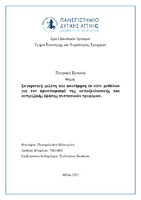| dc.contributor.advisor | Σινάνογλου, Βασιλεία | |
| dc.contributor.author | Παπαμελετίου, Μελπομένη | |
| dc.date.accessioned | 2021-10-13T07:33:26Z | |
| dc.date.available | 2021-10-13T07:33:26Z | |
| dc.date.issued | 2021-09-30 | |
| dc.identifier.uri | https://polynoe.lib.uniwa.gr/xmlui/handle/11400/1331 | |
| dc.identifier.uri | http://dx.doi.org/10.26265/polynoe-1182 | |
| dc.description.abstract | Προκειμένου να πραγματοποιηθεί η συγκριτική μελέτη των μεθόδων in vitro για τον προσδιορισμό της αντιοξειδωτικής και αντιριζικής δράσης, αρχικά, γίνεται αναφορά σε βασικές έννοιες της οξείδωσης, της υπεροξείδωσης των λιπιδίων και του σχηματισμού των ελεύθερων ριζών. Επιπλέον, αποτυπώνονται οι βασικές κατηγορίες των αντιοξειδωτικών ενώσεων, ο μηχανισμός με τον οποίο πραγματοποιείται η δράση τους και ο χαρακτηρισμός της αντιοξειδωτικής και αντιριζικής δράσης και ικανότητας. Στο τρίτο κεφάλαιο ταξινομούνται σε δύο κατηγορίες οι μέθοδοι προσδιορισμού της αντιοξειδωτικής και αντιριζικής δράσης με βάση τον μηχανισμό αντίδρασης που χρησιμοποιούν (SET – Single Electron Transfer ή HAT – Hydrogen Atom Transfer), καταγράφονται οι αρχές μεθόδων, τα πρωτόκολλα καθώς και τα πλεονεκτήματα και τα μειονεκτήματα.
Στο τέταρτο κεφάλαιο παραθέτονται πειραματικά δεδομένα και αποτελέσματα από την εφαρμογή των μεθόδων σε αντιοξειδωτικές ενώσεις και συστατικά τροφίμων, με σκοπό την σύγκριση και την αποτίμηση των αποτελεσμάτων που προκύπτουν και κατ΄επέκταση των μεθόδων, την εξαγωγή συμπερασμάτων σε σχέση με τον συσχετισμό που παρουσιάζουν οι μέθοδοι μεταξύ τους, καθώς και την εκτίμηση των μεθόδων ως προς την σχέση που εμφανίζουν με την βιολογική δράση in vivo των ενώσεων που μελετούν. Παράλληλα, αποτυπώνονται εφαρμογές από σύγχρονες τεχνολογίες. Τέλος το πέμπτο κεφάλαιο περιλαμβάνει τα συμπεράσματα από την συγκριτική μελέτη των μεθόδων in vitro που συνοψίζονται στη σημασία της κατάλληλης επιλογής της μεθόδου και οι παράμετροι που πρέπει να ληφθούν υπόψη, ενώ ταυτόχρονα παρουσιάζονται τα χαρακτηριστικά για τον σχεδιασμό μεθόδου που έχει την δυνατότητα να προσδιορίζει με μεγάλη εγκυρότητα την βιολογική-αντιοξειδωτική δράση in vivo των ενώσεων και των συστατικών τροφίμων. | el |
| dc.format.extent | 86 | el |
| dc.language.iso | el | el |
| dc.publisher | Πανεπιστήμιο Δυτικής Αττικής | el |
| dc.rights | Αναφορά Δημιουργού - Μη Εμπορική Χρήση - Παρόμοια Διανομή 4.0 Διεθνές | * |
| dc.rights.uri | https://creativecommons.org/licenses/by-nc-sa/4.0/deed.el | * |
| dc.subject | DPPH | el |
| dc.subject | FRAP | el |
| dc.subject | Folin-C | el |
| dc.subject | Antioxidants | el |
| dc.subject | Correlation in vivo | el |
| dc.subject | Cyclic voltammetry | el |
| dc.subject | Analytical methods | el |
| dc.subject | ROS | el |
| dc.subject | RNS | el |
| dc.subject | Antioxidant assays | el |
| dc.subject | Antiradical assays | el |
| dc.title | Συγκριτική μελέτη και αποτίμηση in vitro μεθόδων για τον προσδιορισμό της αντιοξειδωτικής και αντιριζικής δράσης συστατικών τροφίμων | el |
| dc.title.alternative | Comparative study and evaluation of in vitro methods for the determination of antioxidant and antiradical activity of food ingredients | el |
| dc.type | Πτυχιακή εργασία | el |
| dc.contributor.committee | Zoumpoulakis, Panagiotis | |
| dc.contributor.committee | Στρατή, Ειρήνη | |
| dc.contributor.faculty | Σχολή Επιστημών Τροφίμων | el |
| dc.contributor.department | Τμήμα Επιστήμης και Τεχνολογίας Τροφίμων | el |
| dc.description.abstracttranslated | In order to carry out the comparative study of assays in vitro for the determination of the antioxidant and antiradical activity, firstly, basic principles of oxidation, lipid peroxidation and free radical formation are mentioned. Moreover, there is the need to imprint the basic categories of antioxidant compounds, the mechanism of their action and the characterization of antioxidant and antiradical activity and capacity. In the third chapter, the assays for the determination of the antioxidant and antiradical activity are classified into two categories based on the reaction mechanism utilized (SET – Single Electron Transfer or HAT – Hydrogen Atom Transfer) and the principles, protocols, advantages and disadvantages of the assays are imprinted.
The fourth chapter includes experimental data and results from the application of the assays on antioxidant compounds and food ingredients, in order to compare and evaluate the results occuring and therefore the assays and to draw conclusions in relation to the correlation between the assays, as well as to assess the assays in relation to the biological activity in vivo of the antioxidant compounds and food ingredients studied. In addition, new and modern technologies and their applications are presented. In the fifth chapter, which is the last one, the conclusions of the comparative study of the assays in vitro are summarized into the importance of the appropriate choice of the assay and the parameters to be taken into consideration, while at the same time the characteristics for the design of an assay, are listed, which makes it possible to determine with good validity the biological-antioxidant activity in vivo of the antioxidant compounds and food ingredients. | el |


